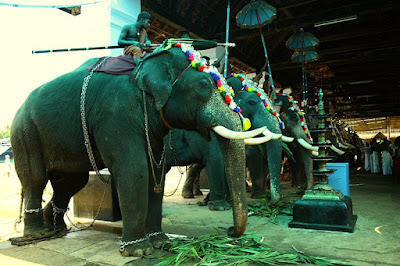 |
| Koodalmanikyam Temple.places-to-visit-in-kerala.blogspot.in |
Koodalmanikyam Temple or Kudal Manikkam Temple / Koodalmanikkam Temple, situated in Irinjalakuda, Thrissur district, Kerala state, India is a unique place of worship because it is dedicated to Bharata, the second younger brother of Sri Rama of the great epic Ramayana; the other brothers being Lakshmana and Shatrughna (the youngest). The Kerala State has the rare distinction of having independent temples dedicated to each of the four brothers of the Ramayana and they together constitute what is called "Nalambalam".The temple situated in the middle of a serene, lush greenery has a big pond within the walled premises. The other large three ponds are outside the temple. It is a rare Hindu temple that we seldom come across in our country.
 |
| Koodalmanikyam Temple. places-to-visit-in-kerala.blogspot.in |
As for the age of this temple, the inscriptions of Chera king Stanu Ravi Varman dated 854 A.D found in the Koodalmanikyam Temple, the ruler gave vast expanse of lands to the temple for maintenance, etc., and they suggest that this temple, once upon a time, was a prominent place of worship among the Kerala temples.
It is believed that people with incurable diseases can find a remedy here and if they come and pray here, they get cured and live happily. Trust is the main factor in such cases. The temple offers 'Brinhal Nivedhyam' to its devotees after every intense prayer. This stuff, it is said, has medicinal properties to cure stomach ailments.
On the day of Thiruvonam, a ritual fasting is observed in this temple and it is called Thriputhari that falls in the month of Thulam (October-November). Considered as the most auspicious occasion, it begins with is an important occasion in the temple. It begins with the cooking of the freshly harvested rice on the temple premises for the first time and is presented to the presiding deity as nivedthyam - offering and then it is distributed among the devotees. This 11-day temple festival that consists of both Vedic and Tantrik rituals is well attended by the devotees who come here to seek God's blessing. The main offering is lotus garland, made of not less than 108 flowers. Tulasi (ocimum sanctum) and thechi (ixora) are also offered to the deity.
 |
| Elephant parade during the annual festivalen.wikipedia.org/ |
 |
| Koodalmanikyam Temple, Panch vadhyam. Temple Purohit |
day as the daily temple ritual is done with deep devotion and dedication.
Tit-Bits:
01. In this temple the puja protocol consists of only three poojas. There is no Usha Kaala Puja and Pantheeradi Puja at Koodalmanikyam Temple. The deity is taken out for a ceremonial procession only during the annual festival. There are plans
to start deeparadhana here as in this temple presently no daily Deeparadhana is performed, which is unusual. The reason is not known.
02. The ten-day annual function begins in the month of Medam (April/May) with the flag-hoisting ceremony, a day after the start of the popularThrissur pooram festival.
03. Unlike the Hindu temples of Tamil Nadu, elsewhere in Kerala, the temple priests-Namboodri Brahmins are allowed to take part in the temple ceremonies only after cleansing themselves at the "Kuttan Kulam" outside the walled temple and then again have to bathe in "Kulipini Theertham" before entering Srikovil/Garbagraha (sanctum Sanctorum).
 |
| Koodalmanikyam temple and Kulipini Theertham en.wikipedia.org |
said to be a chief spiritual leader and a temporal ruler of the Koodalmanikyam Temple and its Estates. The descendants even today enjoy some special rights over the lands and temple. The Thachudaya Kaimals enjoyed spiritual superiority and the rulers of Cochin and Travancore had to pay them obeisance. Even today the ruling spiritual leader has the privilege of being escorted by the Travancore Nayar Brigade. The residence of the Kaimal is the Kottilakkal Palace in Irinjalakuda. The scenario has changed since 1971 with the passing of the 26th amendment of the Indian constitution, the Princely order in India was abolished and the Thachudaya Kaimals lost their ownership of the temple and its estates. Presently the estate and the temple are managed by a Trust under the District Collector. Much land that belonged to Koodalmanikyam, it is reported in the media, was subjected to encroachment.
05. The Koodalmanikyam Devaswom (temple administration) gives clarification that the main deity here is believed to be Bharata, but the idol in the Srikovil is that of Lord Vishnu.
06."Sangameshwara"(Lord of the Confluence) is yet other name associated with the deity at Koodalmanikyam.
Ref:
https://en.wikipedia.org/wiki/Koodalmanikyam_Temple
"Koodalmanikyam Irinjalakkuda". Manorama Online. The-week.com. November 29, 2005. Retrieved 2014-01-18.







.jpg)
.jpeg)
